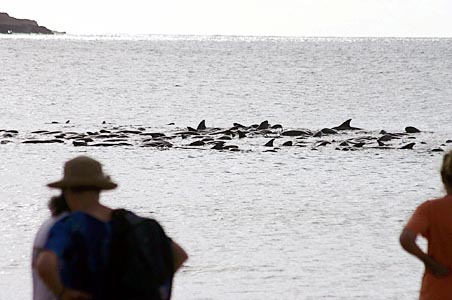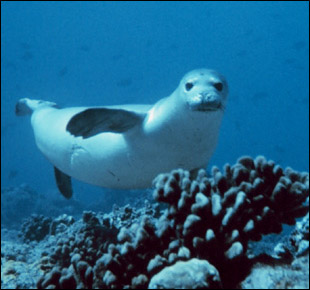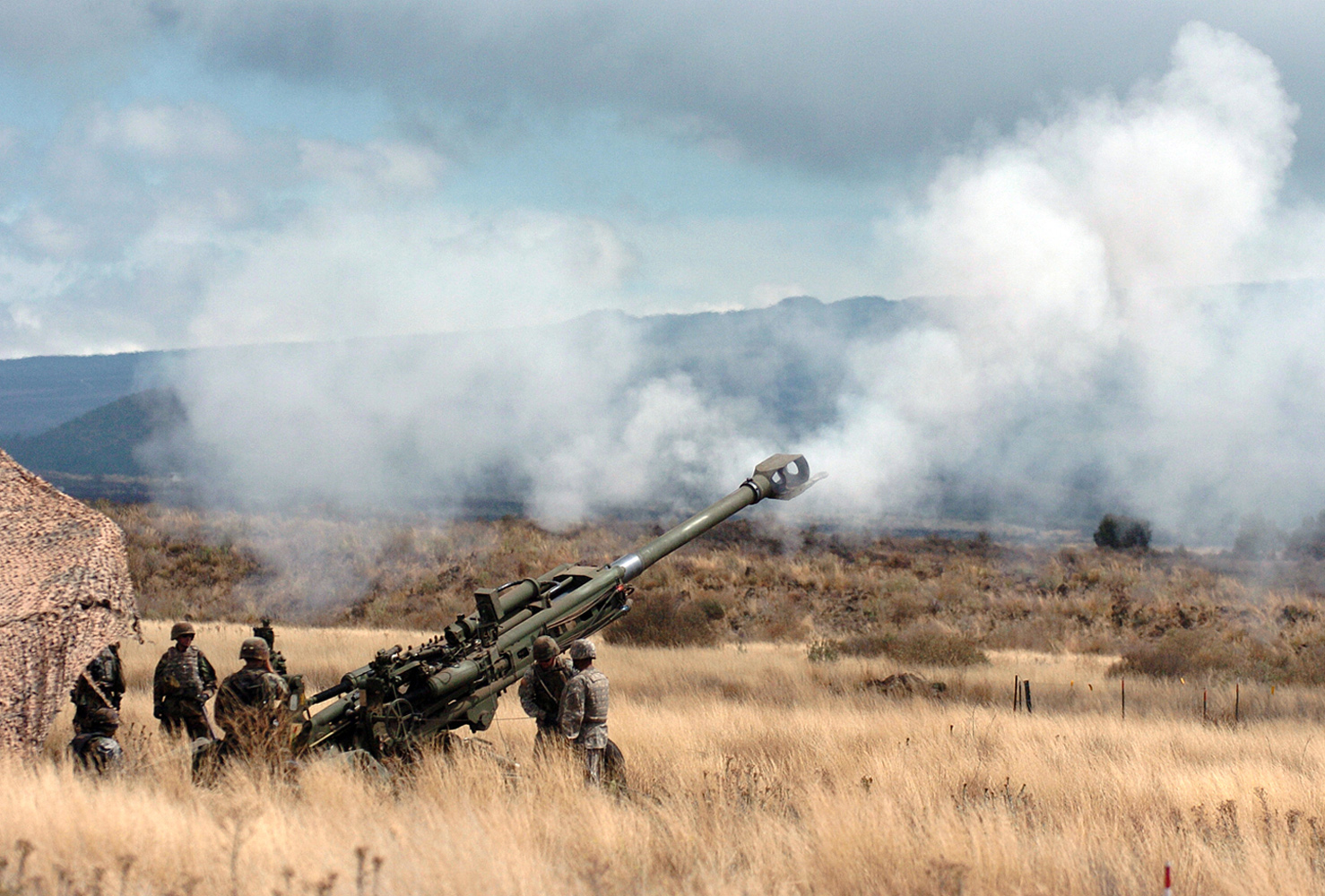Blog
News, updates, finds, stories, and tidbits from staff and community members at KAHEA. Got something to share? Email us at: kahea-alliance@hawaii.rr.com.
Thar She Blows: DU on the move on the Big Island
“Waiki`i Ranch Dust Samples Show No Depleted Uranium” is apparently receiving a skeptical response from local and international scientific experts, according to our friends at Malu `Aina on Hawai`i Island.
The report posted a “statistically insignificant” amount of depleted uranium (DU) in the community of Waiki`i, 8 – 10 miles downwind of Pohakuloa Training Area (PTA), where the Army admitted in 2006 to using DU spotting rounds for its Davy Crockett nuclear weapons system. The test is based on a sample taken by Waiki`i Ranch Depleted Uranium Project Manager, David Bigelow, and sent to a laboratory in England for analysis.
From Malu `Aina guys:
Dr.Rosalie Bertell, PhD, remarks that the lab report “actually says that there IS DU in the sample. There should be zero. It is irrelevant that it is ‘not significant.’” Dr. Bertell — who has been honored by the U.N.as a statisticisn, epidemiologist, and member of the Science Advisory Board, International Joint Commission of the U. S. and Canada — goes on to say: “What you really want to know is whether or not the uranium found in the sample has been fired. This means electron spectroscopy.” Dr. Pang is also skeptical about the term “statiscally insignificant.” He claims that the laboratory’s reading of 1/100 DU, allowing for a measurement error of 1%, could mean the presence of 2% DU in the sample instead of its “zero” interpretation.
Dr. Lorrin Pang, MD, MPH, comments: “it is hard to do statistics with a sample of one,” referring to the single dustpan sample depicted on the front page of the newspaper’s July 22 issue. Dr. Pang, speaking as private citizen, is retired from the Army Medical Corps, is on the Best Doctors of America list 2006-8, and a consultant to the World Health organization (WHO) since 1985. Russell Takata, state radiation chief, is also on record as questioning WRHOA’s methodology.
To label tests a “bust” and conclude that “preliminary results find no health hazard” is simply not supported by fact. Closer to the truth is that we have been told little or nothing about whatever tests may have been conducted by the state or federal governments. Mr Takata refers to “preliminary reviews of about 90% of test results” but gives no data. What about the other 10%? The Army allegedly tested 800 dust samples, but these results have yet to be made available to the state or the public. All of this adds up to sweeping claims of safety, while providing no hard data to back them up. This has been a repeated pattern over the past several years: claims but no data.
The Hawaii County Council by a vote of 8-1 on July 2nd, passed resolution 639-08, calling for the halting of all live-fire that could spread military radiation and independent, comprehensive, testing
`Awa Circle + Talk Story with Kealoha Pisciotta
We heart Kealoha Pisciotta and we’re excited to have her in town! We’ll be talking story and sharing `awa at StudioBe in Chinatown with Kealoha on July 25, 2008.
She’ll be speaking and screening excerpts from Mauna Kea: Temple Under Siege, a film by Na Maka o ka `Aina. We’ll be talking with Kealoha about her experiences and activism in protecting of the sacred summit of Mauna Kea from development. Today, the IFA and a consortium of international institutions has a multi-million dollar proposal to build the largest telescope in the world on the last pristine plateau of Mauna Kea.
`Awa Circle + Talk Story: Sacred Landscapes
Friday, July 25, 2008
7PM to whenever pau
at StudioBe
corner of Beretania + Smith
63 N. Beretania St., 2nd Floor
A Hilo girl, cultural practitioner and former telescope tech, Kealoha’s tireless activism has helped to protect Mauna Kea’s sacred summit from unmitigated telescope development. She is the president of Mauna Kea Anaina Hou.
Mauna Kea, on the island of Hawai’i, is sacred as an elder ancestor and kinolau (physical embodiment) of spiritual deities. The summit area is also ecologically unique, and home the endemic weiku bug, which feeds on insects blown to the summit by updrafts.
Today, thirteen telescopes and support facilities crowd the sacred landscape of Mauna Kea. Even after 30 years of community opposition, a consortium of institutions led by the UH Institute for Astronomy (IFA) continues to propose new telescope construction. Today, over 1,000 individuals regularly drive to telescopes on the summit, leaving behind some 500,000 gallons of human waste toxic chemicals such as ethylene glycol and liquid mercury over the Big Island’s only aquifer.
13 of the richest nations in the world currently pay only $1 per year for their use of the sacred summit.
Construction has damaged and leveled the peaks, spewing dust and facilitating human intrusion that is wreaking havoc on this fragile and unique Hawaiian ecosystem. These impacts, coupled with the introduction of invasive predatory arthropods, are decimating populations of the wekiu bug, one of 11 endemic and imperiled species that call the mountain home.
“If we say yes to more development, we are saying yes to the desecration of our temple and our ancestors, yes to the destruction of our waters, and yes to the possible extinction of life itself.” – Kealoha Pisciotta
Ann Vileisis talks food on KKCR today
Our friends at Malama Kaua`i, today on the radio:
Join hosts Andrea Brower and Keone Kealoha as we discuss the sources of our food and how it gets into our kitchens with author Ann Vileisis joining us by phone. Ann has written an extraordinary book on the last 200 years of food history in the United States, titled Kitchen Literacy. She starts with a simple meal and its context from 1796 and leads us through the next 200 years of change. She illuminates the impact of urbanization, immigration, industrialization (both in the larger sense and in the context of food systems). . KKCR can be found at 91.9 FM or online at www.KKCR.org.
Hawaii County Council Passes Reso on DU: Clean 'em up first!
Mahalo to friends/activists on the Big Island! Ho‘omaika‘i ia! And thanks to everyone who submitted testimony and responded to action alerts–the resolution on depleted uranium passed without bad amendments–you helped make it happen!
From West Hawaii Today:
The council approved a resolution from Puna Councilwoman Emily Naeole that requests the U.S. Army to halt B-2 bombing missions and live firing exercises until it’s determined whether depleted uranium is present at the Pohakuloa Training Area.
Although the resolution does not carry the power of law, the council spent more than six hours Wednesday discussing it and listening to testimony from numerous residents in favor of it.
The council heard from Dr. Lorrin Pang with the state Department of Health who, speaking as a resident, painted a grim picture regarding the lack of information there is on DU levels on the island and the circumstantial evidence that depleted uranium may be responsible for a spike in new cancer cases.
From 2000 through 2004, Pang said 444 new cancer cases were reported on the Big Island, which is more than new cases from the other Hawaiian Islands.
A majority of the county’s new cancer cases were from Kona, where dust originating from PTA usually ends up because of wind, he said. “It is prudent a survey be done to put to rest our uncertainty about (the military’s) record-keeping,” Pang said. “Something’s cooking here on Big Island.”
Depleted uranium was discovered at PTA in 2006, which originated from spotting rounds in Davy Crockett weapons systems tested in the 1960s.
The council approved a few amendments to the resolution, including one from Ka’u Councilman Bob Jacobson that states the “U.S. military shall conduct a search of all records for firing of depleted uranium at (PTA) and all other Hawaii state military sites and release pertinent information to the public.”
An amendment from Council Chairman Pete Hoffmann, Kohala, to remove language in the resolution that requests the military to halt bombing missions and live firing exercises was defeated in an 8-1 vote, with Hoffmann the only one to cast a favorable vote. Hoffmann, who served in the military for more than 28 years, said he agrees the country should not be in Iraq, but because that is the case, the request in question would lead to inadequate training.
Other council members said the Army should find a different place to train until it’s determined if depleted uranium is causing problems for residents and military personnel.
Hamakua Councilman Dominic Yagong said the council’s favorable vote puts the military on notice “that you have to investigate.”
Army Col. Howard Killian told the council the military plans to have a citizen monitoring committee in place by the end of the month. South Kona Councilwoman Brenda Ford plans to introduce a resolution that requests Pang is placed on the committee as the council’s representative.

photo: The Davy Crockett Atomic Battle Group Delivery System fired on the Big Island (island breath post)
Bombs Away! RIMPAC's Back
From Marti:
RIMPAC officially started on Sunday, meaning you can expect beach closures, random explosions, mass strandings, and displays of excessive military force throughout the month of July in Hawaii. Remember, RIMPAC is the bi-annual demonstration of U.S.-occupation that brought us the “Hanalei Bay Incident” in 2004, when 150 melonhead whales attempted to strand themselves because of the Navy’s use of high-intensity active sonar AND the unexplained nearshore explosion that shook the windows of Ewa Beach residents on Oahu in 2006.
This year we can look forward to 150 vessels and 20,000 troops from U.S.-backed militaries — like Russia, South Korea, Australia, Japan, and Peru — engaged in all kinds of wargames, such as assault landings, target practice with live rounds, and high-intensity active sonar.
To move forward with these (and all) exercises as originally outlined in the Navy’s giant range expansion plan, the Navy had to do *something* about the pesky limitations placed on those exercises by the State of Hawaii under the Coastal Zone Management Act (CZMA). This federal law was passed to encourage coastal states to do more to protect their precious coastal resources, including giving these states unique authority to require federal agencies abide by state coastal protections.
Under this unique federal law, the State of Hawaii said the Navy had to do two very reasonable things related to active sonar:
1. In nearshore waters, don’t let the active sonar go above 145 decibels because this is widely accepted (even by the Navy) to be a safe level for marine mammals and humans;
2. In all other situations, abide by the conditions required by Judge Erza in the Federal District Court.
It’s not just that the Navy said “No, we don’t have to follow your stinkin’ coastal protections,” but that the Navy enlisted other government attorneys to say “no” for them in a way that would have undermine all of the cooperative state-federal partnerships set up to protect U.S. coastal resources.
I say “would have” because the legal opinion the Navy ended up with is so poorly argued that it probably won’t have much affect. Of course, it will probably take more court action at some level to sort that out.
The two basic reasons why the Navy’s legal game of Twister fails is:
1. It relies on a court opinion that was vacated, meaning the judge revisited her decision and changed her mind based on new evidence or arguments.
2. The new argument that changed the judge’s mind was that the Endangered Species Act actually says states do, in fact, have the authority to protect endangered marine species to greater extent than the federal government. And it’s well accepted that the Endangered Species Act trumps the Marine Mammal Protection Act when it comes to endangered marine species.
Sigh.
We’ll continue to keep you updated on this saga. In the meantime, you can send your thanks to the State Planning and Director Abbey Mayer for standing up for coastal protections in Hawai`i nei.
Hawaii County Council to Consider DU Cleanup Reso
The military finally admitted in 2006 that depleted uranium (DU) spotting rounds for the Davy Crockett nuclear weapon system have been used at Schofield Barracks, the Pohakuloa Training Area, and possibly Makua Valley between 1962 and 1968.
The Army long denied ever using DU in Hawai‘i; reassuring residents in countless public hearings and environmental impact statements that “a records search for depleted uranium rounds was conducted and determined that these types of munitions were never part of the Army’s inventory in Hawai‘i… .”
The U.S. military has an obligation to be candid with the public about its activities in Hawaii because they have far-reaching implications for our health and welfare. The people of Hawaii will be left to suffer the consequences of U.S. military activities long after they have moved on to other fronts. That is why we must be vigilant and demand answers to our questions: Have other DU spotting rounds and the more hazardous DU armor penetrating rounds been used as well? What don’t we know about existing military contamination? What should we know before we even begin to consider pending expansion of live fire activities?
From friends on the Big Island:
The Hawaii County Council will be hearing Resolution 639-08 Urging the U.S. Military to address the hazards of depleted uranium (DU) at the Pohakuloa Training Area (PTA). The hearing is set for Wednesday, July 2nd 8:30 AM at the Council room on the 2nd floor of the Hilo Ben Franklin building.
You can support by submitting this letter to all Hawaii County council members, urging their support of resolution 639-08.
A growing number of people feel it is time to stop all live-fire and shut down PTA and get to the root of the problem. Stopping all live-fire at PTA is a key public safety and environmental conservation issue. Any live-fire training increases the risk of spreading the radiation contamination. There needs to be a thorough independent assessment and clean-up of the existing contamination before live-fire training can even be considered!
Unfortunately, Council Chair Pete Hoffmann has already prepared an amendment to delete the call for a complete halt to all live firing at PTA which is the heart of the matter. Don’t let this happen!
“… Just as smoking affects the primary user as well as those inhaling second hand smoke, the airborne products of DU burning remain suspended for long periods and travel great distances in the atmosphere. We do not know all the toxicity of the airborne DU products (nano-toxicity) but some forms (DU oxides) we do know can persist in the body for decades. When internalized DU emits the most dangerous type of radiation, alpha radiation. Animals with implanted alpha emitters have shown high cancer rates and birth defects – which can pass on to subsequent, UNEXPOSED generations.
- Lorrin Pang, MD, MPH (speaking as a private citizen). Dr. Pang was born and raised in Hawaii, and is Retired Army Medical Corp, Best Doctors of America list 2006-8, Consultant to the World Health organization (WHO) since 1986, Consultant Glaxo Smith Kline
Planting Your Vote, Taking Names
Since the announcement late last week about the attempt to corrupt and co-opt traditional farmers’ attempt to secure a simple 10-year moratorium on GMO taro, we’ve heard your outrage! Many of you have written to ask for details about the vote. You’re getting ready to plant your vote, and you’re taking names!
NINE Ayes (Voted pro-GMO in favor of amendments)
Rep. Clift Tsuji, Committee Chair (South Hilo to Kurtistown, Big Island) reptsuji@Capitol.hawaii.gov
Rep. Tom Brower (Waikiki/Alamoana, Oahu) repbrower@Capitol.hawaii.gov
Rep. Jerry L. Chang (Keaukaha to South Hilo, Big Island) repchang@Capitol.hawaii.gov
Rep. Robert Herkes (Puna to Kona, Big Island) repherkes@Capitol.hawaii.gov
Rep. Joey Manahan (Sand Island, Mokuea, Kalihi Kai, Kapalama, Oahu) repmanahan@Capitol.hawaii.gov
Rep. Ryan I. Yamane (Waipahu/Mililani, Oahu) repyamane@Capitol.hawaii.gov
Rep. Kyle T. Yamashita (Pukalani to Ulupalakua, Maui) repyamashita@Capitol.hawaii.gov
TWO Ayes with reservations
Rep. Glenn Wakai (Moanalua to Salt Lake, Oahu) repwakai@Capitol.hawaii.gov
Rep. Corinne Ching (Nuuanu/Alewa Heights, Oahu) repching@Capitol.hawaii.gov
THREE Nos (Voted in support for true protection of Haloa)
Rep. Lyla Berg (Kahala to Hahaione, Oahu) repberg@Capitol.hawaii.gov
Rep. Faye P. Hanohano (Puna to Pahoa, Big Island) rephanohano@Capitol.hawaii.gov
Rep. Colleen Rose Meyer (Kaneohe to Laie, Oahu) repmeyer@Capitol.hawaii.gov
The “poison pill” amendments prohibit any future moratoriums on any GMO, even at the county level. At the same time, these legislators reduced the moratorium to 5 years and limited the protected taro plants to the Hawaiian varieties only. Read the amendments:
http://www.capitol.hawaii.gov/session2008/CommReports/SB958_HD2_HSCR1769-08_.htm
WHAT YOU CAN DO
Call Your Representatives:
http://www.capitol.hawaii.gov/site1/house/members/members.asp
Call Your Senators:
http://www.capitol.hawaii.gov/site1/senate/members/members.asp
You can also copy and paste the email addresses below, to email all of them:
reps@Capitol.hawaii.gov, repawana@Capitol.hawaii.gov, repbelatti@Capitol.hawaii.gov, repberg@Capitol.hawaii.gov, repbertram@Capitol.hawaii.gov, repbrower@Capitol.hawaii.gov, repcabanilla@Capitol.hawaii.gov, repcaldwell@Capitol.hawaii.gov, repcarroll@Capitol.hawaii.gov, repchang@Capitol.hawaii.gov, repching@Capitol.hawaii.gov, repchong@Capitol.hawaii.gov, repevans@Capitol.hawaii.gov, repfinnegan@Capitol.hawaii.gov, repgreen@Capitol.hawaii.gov, rephanohano@Capitol.hawaii.gov, rephar@Capitol.hawaii.gov, repherkes@Capitol.hawaii.gov, repito@Capitol.hawaii.gov, repkaramatsu@Capitol.hawaii.gov, replee@Capitol.hawaii.gov, repluke@Capitol.hawaii.gov, repmagaoay@Capitol.hawaii.gov, repmanahan@Capitol.hawaii.gov, repmarumoto@Capitol.hawaii.gov, repmckelvey@Capitol.hawaii.gov, repmeyer@Capitol.hawaii.gov, repmizuno@Capitol.hawaii.gov, repmorita@Capitol.hawaii.gov, repnakasone@Capitol.hawaii.gov, repnishimoto@Capitol.hawaii.gov, repboshiro@capitol.hawaii.gov, repmoshiro@Capitol.hawaii.gov, reppine@Capitol.hawaii.gov, reprhoads@Capitol.hawaii.gov, repsagum@Capitol.hawaii.gov, repsaiki@Capitol.hawaii.gov, repsay@Capitol.hawaii.gov, repshimabukuro@Capitol.hawaii.gov, repsonson@Capitol.hawaii.gov, repsouki@Capitol.hawaii.gov, reptakai@Capitol.hawaii.gov, reptakamine@Capitol.hawaii.gov, reptakumi@Capitol.hawaii.gov, repthielen@Capitol.hawaii.gov, reptokioka@Capitol.hawaii.gov, reptsuji@Capitol.hawaii.gov, repwakai@Capitol.hawaii.gov, repward@Capitol.hawaii.gov, repwaters@Capitol.hawaii.gov, repyamane@Capitol.hawaii.gov, repyamashita@Capitol.hawaii.gov, sens@Capitol.hawaii.gov, senbaker@Capitol.hawaii.gov, senbunda@Capitol.hawaii.gov, senchunoakland@Capitol.hawaii.gov, senenglish@Capitol.hawaii.gov, senespero@Capitol.hawaii.gov, senfukunaga@Capitol.hawaii.gov, sengabbard@Capitol.hawaii.gov, senhanabusa@Capitol.hawaii.gov, senhee@Capitol.hawaii.gov, senhemmings@Capitol.hawaii.gov, senhooser@Capitol.hawaii.gov, sendige@Capitol.hawaii.gov, senihara@Capitol.hawaii.gov, seninouye@Capitol.hawaii.gov, senkim@Capitol.hawaii.gov, senkokubun@Capitol.hawaii.gov, senmenor@Capitol.hawaii.gov, sennishihara@Capitol.hawaii.gov, sensakamoto@Capitol.hawaii.gov, senslom@Capitol.hawaii.gov, sentaniguchi@Capitol.hawaii.gov, sentokuda@Capitol.hawaii.gov, sentrimble@Capitol.hawaii.gov, sentsutsui@Capitol.hawaii.gov, senwhalen@Capitol.hawaii.gov
Again, we are NOT giving up. With your help, we are all our telling our elected representatives that Hawaii’s traditional farmers and those who support them KNOW their humble, grassroots efforts have been stolen and co-opted in favor of biotech corporations. We can do better!

















